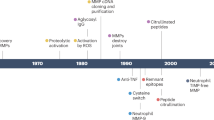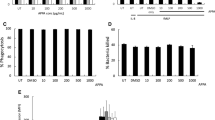Abstract
The serine proteinases elastase and cathepsin G from polymorphonuclear granulocytes play a critical role in articular cartilage degradation, not only as proteolytic enzymes able to degrade the extracellular matrix but also by additionally modulating the level of active matrix metalloproteinases, key enzymes of the proteolytic destruction of cartilage during rheumatoid arthritis. The aim of our study was to examine whether antiinflammatory drugs and selected compounds inhibited elastase and cathepsin G, and also to determine whether it is necessary to use a highly purified elastase preparation to screen drugs for their ability to block the activity of this enzyme. Eglin C and the glycosaminoglycan-peptide complex DAK-16, at concentrations ranging from 10−9 to 10−4 M, dose-dependently inhibited elastase and cathepsin G while the nonsteroidal anti-inflammatory drugs oxyphenbutazone, phenylbutazone, sulfinpyrazone and diclofenac-Na required high concentrations to demonstrate some inhibitory effects on the activity of both enzymes. None of the other anti-inflammatory drugs tested at a concentration of 10−4 M such as acetylsalicylic acid, dexamethasone,indomethacin, ketoprofen, naproxen, oxaceprol, pirprofen and tiaprofenic acid demonstrated any marked inhibitory activity on either of these proteinases. Only a few drugs, when dosed therapeutically, achieved synovial fluid concentrations sufficient to inhibit the activities of both proteinases. The antirheumatic drugs demonstrated similar inhibition profiles in purified or partially purified elastase preparations. Thus the leukocyte extract containing the partially purified elastase and cathepsin G which can be rapidly and easily prepared at low costs appears to be an efficient mean of screening potentially new therapeutic agents for their ability to inhibit leukocyte elastase and cathepsin G.
Similar content being viewed by others
References
Fassbender HG, Simmling-Annefeld M. The potential aggressiveness of synovial tissue in rheumatoid arthritis. J Pathol 1983;139:399–406.
Chu CQ, Field M, Allard S, Abney E, Feldmann M, Maini RN. Detection of cytokines at the cartilage/pannus junction in patients with rheumatoid arthritis: implications for the role of cytokines in cartilage destruction and repair. Br J Rheumatol 1992;31:653–61.
Woodley DE, Crossley M, Evanson JM. Collagenase at sites of cartilage erosions in the rheumatoid joint. Arthr Rheum 1977;20:1231–9.
Case JP, Lafyatis R, Remmers EF, Kumkumian GK, Wilder RL. Transin/stromelysin expression in rheumatoid synovium. A transformation-associated metalloproteinase secreted by phenotypically invasive synoviocytes. Am J Pathol 1989;135: 1055–64.
Bromley M, Wooley DE. Histopathology of the rheumatoid lesions. Identification of cell types at sites of cartilage erosion. Arthr Rheum 1984;27:857–63.
Barrie HJ. Pathology of femoral heads in patients with rheumatoid disease. J Rheumatol 1990;17:448–59.
Larbre JP, Moore AR, Da Silva JAP, Iwamura H, Ioannou Y, Willoughby DA. Direct degradation of articular cartilage by rheumatoid synovial fluid: Contribution of proteolytic enzymes. J Rheumatol 1994;21:1796–801.
Malemud CJ, Janoff A. Identification of neutral proteases in human neutrophil granules that degrade articular cartilage proteoglycan. Arthr Rheum 1992;18:361–8.
Mok MT, Ilic MZ, Handley CJ, Robinson HC. Cleavage of proteoglycan aggregate by leucocyte elastase. Arch Biochem Biophys 1992;292:442–7.
Bader DL, Kempson GE, Egan J, Gilbey W, Barrett AJ. The effects of selective matrix degradation on the short-term compressive properties of adult human articular cartilage. Biochem Biophys Acta 1992;1116:147–54.
Jasin HE, Taurog JD. Mechanisms of disruption of the articular cartilage surface in inflammation. J Clin Invest 1991;87:1531–6.
Damiano VV, Kucich U, Murer E, Laundenslager N, Weinbaum G. Ultrastructural quantitation of peroxidase- and elastase-containing granules in human neutrophils. Am J Pathol 1988;131:235–45.
Werb Z, Gordon S. Elastase secretion by stimulated macrophages: characterization and regulation. J Exp Med 1975;142:361–77.
Boudier C, Godeau G, Hornebeck W, Robert I, Bieth JG. The elastolytic activity of cathepsin G: an ex vivo study with dermal elastin. Am J Respir Cell Mol Biol 1991;4:497–503.
Janusz MJ, Doherty NS. Degradation of cartilage matrix proteoglycan by human neutrophils involves both elastase and cathepsin G. J Immunol 1991;146:3922–8.
McDonald JA, Kelly DG. Degradation of fibronectin by human leukocyte elastase: release of biologically active fragments. J Biol Chem 1980;255:8848–58.
Pipoly DJ, Crouch EC. Degradation of native type IV procollagen by human neutrophil elastase: implications for leukocyte-mediated degradation of basement membranes. Biochemistry 1987;26:5748–54.
Schmidt W, Egbring R, Havemann K. Effect of elastase-like and chymotrypsin-like neutral proteases from human granulocytes on isolated clotting factors. Thromb Res 1975;6:315–26.
Nagase H, Enghild JJ, Suzuki K, Salvesen G. Stepwise activation mechanisms of the precursor of matrix metalloproteinase 3 (stromelysin) by proteinases and (4-aminophenyl) mercuric acetate. Biochemistry 1990;29:5783–9.
Okada Y, Nakanishi I. Activation of matrix metalloproteinase 3 (stromelysin) and matrix metalloprotenase 2 (“gelatinase”) by human neutrophil elastase and cathepsin G. FEBS Lett 1989;249:353–6.
Okada Y, Watanabe S, Nakanishi I, Kishi J, Hayakawa T, Watorek J, et al. Inactivation of tissue inhibitor of metalloproteinases by neutrophil elastase and other serine proteinases. FEBS Lett 1988;229:157–60.
Hazuda DJ, Strickler J, Kueppers F, Simon PL, Young PR. Processing of precursor interleukin 1 beta and inflammatory disease. J Biol Chem 1990;265:6318–22.
Dayer JM, Beutler B, Cerami A. Cachectin/tumor necrosis factor stimulates collagenase and prostglandin E2 production by human synovial cells and dermal fibroblasts. J Exp Med 1985;162:2163–8.
Abbink JJ, Kamp AM, Nujens JH, Swaak TG, Hack CE. Proteolytic inactivation of alpha-1-antichymotrypsin by neutrophils in arthritic joints. Arthr Rheum 1993;36:168–80.
Travis J. Structure, function and control of neutrophil proteinases. Am J Med 1988;84:37–42.
Chidwick K, Winyard PG, Zhang Z, Farrell AJ, Blake DR. Inactivation of the elastase inhibitory activity of alpha-1-antitrypsin in fresh samples of synovial fluid from patients with rheumatoid arthritis. Ann Rheum Dis 1991;50:915–6.
Baugh RJ, Travis J. Human leukocyte granule elastase. Rapid isolation and characterization. Biochemistry 1976;15:836–41.
Engelbrecht S, Pieper E, Macartney HW, Rautenberg W, Wenzel HR, Tschesche H. Separation of the human leucocyte enzymes alanine aminopeptidase, cathepsin G, collagenase, elastase and myeloperoxidase. Hope-Seylers Z Physiol Chem 1982;363:305–15.
Lowry OH, Rosebrough NJ, Farr AL, Randall RJ. Protein measurement with the folin phenol reagent. J Biol Chem 1951;193:265–75.
Nakajima K, Powers JC, Ashe BA, Zimmerman M. Mapping the extended substrate binding site of cathepsin G and human leukocyte elastase. J Biol Chem 1979;254:4027–32.
Kalbhen DA. Chemical model of osteoarthritis: A pharmacological evaluation. J Rheumatol 1987;14:130–4.
Kalbhen DA. Analytical investigations of the cartilage extract in RumalonR. Med Pharmacol Exp 1966;15:344–50.
Burkhardt D, Ghosh P. Laboratory evaluation of antiarthritic drugs as potential chondroprotective agents. Semin Arthr Rheum 1987;17:30–4.
Schug BS, Kalbhen DA. Influence of chloroquine and other substances on the collagenolytic activity in human osteoarthritic cartilage in vitro. Arzneim Forsch/Drug Res 1995;45:285–9.
Baici A, Salgam P, Fehr K, Böni A. Inhibition of human lysosomal elastase by the cartilage bone marrow extract RumalonR. Z Rheumatol 1981;40:44–6.
Steinmeyer J, Kalbhen DA. Pharmacological influence on polymorphonuclear granulocytes elastase under various test conditions. Arzneim Forsch/Drug Res 1990;40:196–200.
Bassleer C, Gysen P, Bassleer R, Franchimont P. Effects of peptide glycosaminoglycans complex on human chondrocytes cultivated in three dimensions. Biochem Pharmacol 1988;37:1939–45.
Braun NJ, Bodmer JL, Virca D, Metz-Virca G, Maschler R, Bieth JG, et al. Kinetic studies on the interaction of eglin C with human leukocyte elastase and cathepsin G. Biol Chem Hoppe-Seyler 1987;368:299–308.
Baici A, Seemüller U. Kinetics of the inhibition of human leucocyte elastase by eglin from the leech Hirudo medicinalis. Biochem J 1984;218:829–33.
Schnebli HP, Seemüller U, Fritz H, Maschler R, Liersch M, Virca GD, et al. Eglin C, a pharmacologically active elastase inhibitor. Eur J Respir Dis 1985;66:66–70.
Kruze D, Fehr K, Menninger H, Böni A. Effect of antirheumatic drugs on neutral proteases from human leucocyte granules. Z Rheumatol 1976;35:337–46.
Stephens RW, Walton EA, Ghosh P, Taylor TKF, Gramse M, Havemann K. A radioassay for proteolytic cleavage of isolated cartilage proteoglycan. 2. Inhibition of human leukocyte elastase and cathepsin G by anti-inflammatory drugs. Arzneim Forsch/Drug Res 1980;30:2108–12.
Lentini A, Ternai B, Ghosh P. Synthetic inhibitors of human granulocyte elastase. Part 4. Inhibition of human granulocyte elastase and cathepsin G by non-steroidal anti-inflammatory drugs (NSAID)s. Biochem Int 1987;15:1069–70.
Marossy K, Szabo GC, Pozsgay M, Elodi P. Mapping of the substrate-binding site of the human granulocyte elastase by the aid of tripeptidyl-p-nitroanilide substrates. Biochem Biophys Res Commun 1980;96:762–9.
Author information
Authors and Affiliations
Additional information
accepted by M. J. Parnham
Rights and permissions
About this article
Cite this article
Steinmeyer, J., Kalbhen, D.A. The inhibitory effects of antirheumatic drugs on the activity of human leukocyte elastase and cathepsin G. Inflamm Res 45, 324–329 (1996). https://doi.org/10.1007/BF02252944
Received:
Revised:
Accepted:
Issue Date:
DOI: https://doi.org/10.1007/BF02252944




